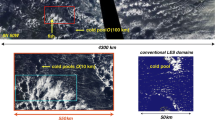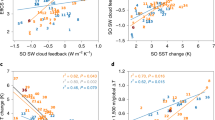Abstract
The Canadian Centre for Climate Modelling and Analysis atmospheric general circulation model (AGCM4) is used to study the role of shallow convection in the hydrologic and energy cycles of the atmosphere. Sensitivity tests with AGCM4 show a marked effect of the parameterization of shallow convection in the model. In particular, including the parameterization of shallow convection produces considerably enhanced vertical mixing and decreased stratiform cloud amounts in the lower subtropical atmosphere over the oceans. The differences in simulated stratiform cloud amounts are associated with a change in the globally averaged outgoing shortwave radiative flux at the top of the atmosphere of about 11 W m−2. Additionally, precipitation rates are considerably reduced for stratiform clouds and enhanced for convective clouds in the subtropics, if the parameterization of shallow convection is included in the model. Additional tests show that the simulated responses in cloud amounts and precipitation to the treatment of shallow convection are robust. Additional simulations with modified closures for deep convection and other changes to the treatment of convection in the model still lead to similar responses of the model results.















Similar content being viewed by others
References
Abdella K, McFarlane N (1996) Parameterization of the surface-layer exchange coefficients for atmospheric models. Bound Layer Meteorol 80:223–248
Albrecht BA (1981) Parameterization of trade-cumulus cloud amounts. J Atmos Sci 38:97–105
Arakawa A, Schubert WH (1974) Interaction of a cumulus cloud ensemble with the large-scale environment, Part I. J Atmos Sci 31:674–701
Barker HW (1996) A parameterization for computing grid-averaged solar fluxes for inhomogeneous marine boundary layer clouds Part I: Methodology and homogeneous biases. J Atmos Sci 53:2298–2303
Barkstrom BR, Smith GL (1986) The earth radiation budget experiment: science and implementation. Rev Geophys 24:379–390
Betts AK, Ridgway W (1988) Coupling of the radiative, convective, and surface fluxes over the equatorial Pacific. J Atmos Sci 45:522–536
Boer GJ (1995) A hybrid moisture variable suitable for spectral GCMs. Research activities in atmospheric and oceanic modelling. Report No. 21, WMO/TD-No. 665, World Meteorological Organization, Geneva
Boer GJ, Yu B (2003) Climate sensitivity and climate state. Clim Dyn. 21:167–176
Bretherton CS (2003) Climate Process Team (CPT) on low-latitude cloud feedbacks on climate sensitivity. Project summary, University of Washington, p 15
Brown AR, Cederwall RT, Chlond A, Duynkerke PG, Golaz JC, Khairoutdinov M, Lewellen DC, Lock AP, MacVean MK, Moeng CH, Neggers RAJ, Siebesma AP, Stevens B (2002) Large-eddy simulation of the diurnal cycle of shallow cumulus convection over land. Q J R Meteor Soc 128:1075–1093
Ciesielski PE, Schubert WH, Johnson RH (1999) Large-scale heat and moisture budgets over the ASTEX region. J Atmos Sci 56:3241–3261
Dobbie JS, Li J, Chýlek P (1999) Two and four stream optical properties for water clouds and solar wavelengths. J Geophys Res 104:2067–2079
Emanuel KA (1994) Atmospheric convection. Oxford University Press, New York, p 580
Grant ALM (2001) Cloud-base fluxes in the cumulus-capped boundary layer. Q J R Meteor Soc 127:407–421
Gregory D (1997) Sensitivity of general circulation model performance to convective parameterization. In: Smith RK (ed) The physics and parameterization of moist atmospheric convection. Kluwer, Dordrecht, pp 463–482
Hack JJ (1994) Parameterization of moist convection in the National Center for Atmospheric Research Community Climate Model (CCM2). J Geophys Res 99:5551–5568
Haywood J, Boucher O (2000) Estimates of the direct and indirect radiative forcing due to tropospheric aerosols: a review. Rev Geophys 38:513–543
Holland JZ, Rasmusson EM (1973) Measurements of atmospheric mass, energy, and momentum budgets over a 500-kilometer square of tropical ocean. Mon Wea Rev 101:44–55
Johnson RH, Lin X (1997) Episodic trade wind regimes over the western Pacific warm pool. J Atmos Sci 54:2020–2034
Johnson RH, Rickenbach TM, Rutledge SA, Ciesielski PE, Schubert WH (1999) Trimodal characteristics of tropical convection. J Clim 12:2397–2418
Khairoutdinov M, Kogan Y (2000) A new cloud physics parameterization in a large-eddy simulation of marine stratocumulus. Mon Wea Rev 128:229–243
Kiehl JT, Hack JJ, Bonan GB, Boville BA, Briegleb BP, Williamson DL, Rasch PJ (1996) Description of the NCAR Community Climate Model (CCM3). NCAR technical note NCAR/TN-420+STR, National Center for Atmospheric Research, Boulder, Colorado, 152 pp
Laprise R, Girard E (1990) A spectral general circulation model using a piecewise-constant finite element representation on a hybrid vertical coordinate system. J Clim 3:32–52
Li J, Barker HW (2002) Accounting for unresolved clouds in a 1D infrared radiative transfer model Part II: horizontal variability of cloud water path. J Atmos Sci 59:3325–3342
Lindner TH, Li J (2000) Parameterization of the optical properties for water clouds in the infrared. J Clim 13:1797–1805
Lohmann U, Roeckner E (1996) Design and performance of a new cloud microphysics scheme developed for the ECHAM general circulation model. Clim Dyn 12:557–572
Lohmann U, von Salzen K, McFarlane N, Leighton HG, Feichter J (1999) Tropospheric sulphur cycle in the Canadian general circulation model. J Geophys Res 104:26833–26858
McCaa JR, Bretherton CS (2004) A new parameterization of shallow cumulus convection and its application to marine subtropical cloud-topped boundary layers Part II: Regional simulations of marine boundary layer clouds. Mon Wea Rev 132:883–896
McFarlane NA, Boer GJ, Blanchet J-P, Lazare M (1992) The Canadian Climate Centre second-generation general circulation model and its equilibrium climate. J Clim 5:1013–1044
Menon S, Del Genio AD, Koch D, Tselioudis G (2002) GCM simulations of the aerosol indirect effect: Sensitivity to cloud parameterization and aerosol burden. J Atmos Sci 59:692–713
Merryfield WJ, McFarlane N, Lazare M (2003) A generalized hybrid transformation for tracer advection. WGNE Blue Book, WMO, pp 3:13–3:14
Monin AS, Obukhov AM (1954) Basic regularity in turbulent mixing in the surface layer of atmosphere. Akad Nauk SSSR Trud Geofiz Inst 24:163–187
Nitta T, Esbensen S (1974) Heat and moisture budget analyses using BOMEX data. Mon Wea Rev 102:17–28
Norris JR (1998a) Low cloud type over the ocean from surface observations Part I: Relationship to surface meteorology and the vertical distribution of temperature and moisture. J. Clim 11:369–382
Norris JR (1998b) Low cloud type over the ocean from surface observations. Part II: geographical and seasonal variation. J Clim 11:383–403
Ogura Y, Cho HR (1973) Diagnostic determination of cumulus cloud populations from observed large-scale variables. J Atmos Sci 30:1276–1286
Raga GB, Jensen JB, Baker MB (1990) Characteristics of cumulus band clouds off the coast of Hawaii. J Atmos Sci 47:338–355
Rasmusson EM, Mo KC (1996) Large-scale atmospheric moisture cycling as evaluated from NMC global analysis and forecast products. J Clim 9:3276–3297
Riehl H, Malkus JS (1957) On the heat balance and maintenance of circulation in the trades. Q J R Meteor Soc 83:21–29
Riehl H, Yeh TC, Malkus JS, LaSeur NE (1951) The northeast trade of the Pacific Ocean. Q J R Meteor Soc 77:598–626
Rossow WB, Walker AW, Beuschel DE, Roiter MD (1996) International Satellite Cloud Climatology Project (ISCCP). Documentation of new cloud datasets. WMO/TD-No. 737, World Meteorological Organization, 115 pp
von Salzen K, McFarlane NA (2002) Parameterization of the bulk effects of lateral and cloud-top entrainment in transient shallow cumulus clouds. J Atmos Sci 59:1405–1429
von Salzen K, Leighton HG, Ariya PA, Barrie LA, Gong SL, Blanchet J-P, Spacek L, Lohmann U, Kleinman LI (2000) Sensitivity of sulphate aerosol size distributions and CCN concentrations over North America to SO x emissions and H2O2 concentrations. J Geophys Res 105:9741–9765
Scinocca JF, McFarlane NA (2004) The variability of modeled tropical precipitation. J Atmos Sci 61:1993–2015
Siebesma AP, Cuijpers WM (1995) Evaluation of parametric assumptions for shallow cumulus convection. J Atmos Sci 52:650–666
Siebesma AP, Jakob C Lenderink G et al (2004) Cloud representation in general-circulation models over the northern Pacific Ocean: a EUROCS intercomparison study. Q J R Meteor Soc 130:3245–3267
da Silva A, Young CC, Levitus S (1994) Atlas of surface marine data 1994 Vol. 1: algorithms and procedures. NOAA atlas NESDIS 6, US Department of Commerce, Washington, DC, 83 pp
Simpson J (1992) Global circulation and tropical cloud activity. In: Theon JS, Matsuno T, Sakata T, Fugono N (eds) The global role of tropical rainfall. A. Deepak Publishing, Hampton, pp 77–92
Slingo JM (1987) The development and verification of a cloud prediction scheme for the ECMWF model. Q J R Meteor Soc 113:899–927
Stevens B, Ackerman AS, Albrecht BA, Brown AR, Chlond A, Cuxart J, Duynkerke PG, Lewellen DC, Macvean MK, Neggers RAJ, Sanchez E, Siebesma AP, Stevens DE (2001) Simulation of trade wind cumuli under a strong inversion. J Atmos Sci 58:1870–1891
Taylor KE, Williamson D, Zwiers F (2000) The sea surface temperature and sea-ice concentration boundary conditions for AMIP II simulations. PCMDI Report No. 60, Program for Climate Model Diagnosis and Intercomparison, Lawrence Livermore National Laboratory, Livermore, California, 25 pp
Tiedtke M (1989) A comprehensive mass flux scheme for cumulus parameterization in large-scale models. Mon Wea Rev 117:1779–1800
Tiedtke M, Heckley WA, Slingo JM (1988) Tropical forecasting at ECMWF: The influence of physical parameterization on the mean structure of forecasts and analyses. Q J R Meteor Soc 114:639–664
Verseghy DL, McFarlane NA, Lazare M (1993) A Canadian land surface scheme for GCMs: II Vegetation model and coupled runs. Int J Climatol 13:347–370
Xie PP, Arkin PA (1996) Analyses of global monthly precipitation using gauge observations, satellite estimates, and numerical model predictions. J Clim 9:840–858
Xie PP, Arkin PA (1997) Global precipitation: A 17-year monthly analysis based on gauge observations, satellite estimates, and numerical model outputs. Bull Am Meteorol Soc 78:2539–2558
Xie S, Xu K-M, Cederwall RT, Bechtold P, Del Genio AD, Klein SA, Cripe DG, Ghan SJ, Gregory D, Iacobellis SF, Krueger SK, Lohmann U, Pech JC, Randall DA, Rotstayn LD, Somerville RCJ, Sud YC, von Salzen K, Walker GK, Wolf A, Yio JJ, Zhang GJ, Zhang M (2002) Intercomparison and evaluation of cumulus parametrizations under summertime midlatitude continental conditions. Q J R Meteor Soc 128:1095–1136
Xu K-M, Randall DA (1996) A semiempirical cloudiness parameterization for use in climate models. J Atmos Sci 53:3084–3102
Yanai M, Esbensen S, Cho JH (1973) Determination of bulk properties of tropical cloud clusters from large-scale heat and moisture budgets. J Atmos Sci 30:611–627
Zhang GJ, McFarlane NA (1995) Sensitivity of climate simulations to the parameterization of cumulus convection in the CCC-GCM. Atmos Ocean 3:407–446
Acknowledgments
We are grateful to two anonymous reviewers for their helpful comments which helped us to improve the manuscript. We are also grateful to our colleagues George Boer, Jiangnan Li, William Merryfield, John Scinocca, Richard Harvey, and Bernard Miville for discussions of the results and contributions to model development and model diagnostics. This study has been funded by the Meteorological Service of Canada with additional support from the NSERC-CFCAS project Modelling of Clouds for Climate (MOC2).
Author information
Authors and Affiliations
Corresponding author
Rights and permissions
About this article
Cite this article
von Salzen, K., McFarlane, N.A. & Lazare, M. The role of shallow convection in the water and energy cycles of the atmosphere. Clim Dyn 25, 671–688 (2005). https://doi.org/10.1007/s00382-005-0051-2
Received:
Accepted:
Published:
Issue Date:
DOI: https://doi.org/10.1007/s00382-005-0051-2




